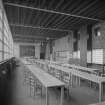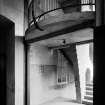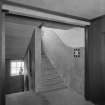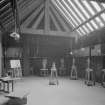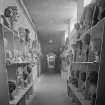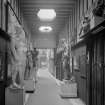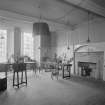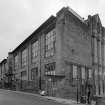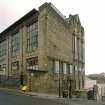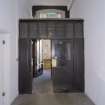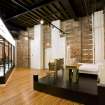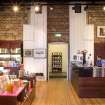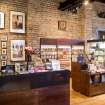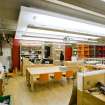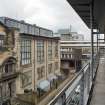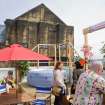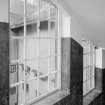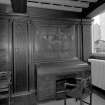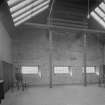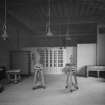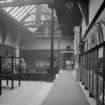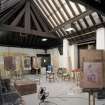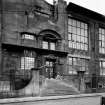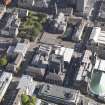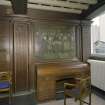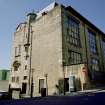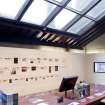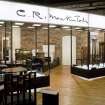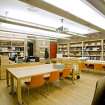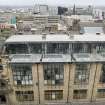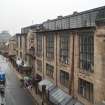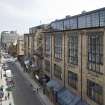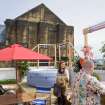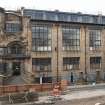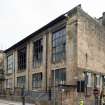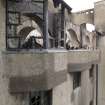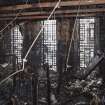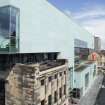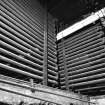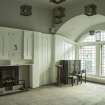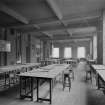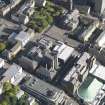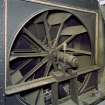Glasgow, 167 Renfrew Street, Glasgow School Of Art
College (19th Century)
Site Name Glasgow, 167 Renfrew Street, Glasgow School Of Art
Classification College (19th Century)
Alternative Name(s) Garnethill; Mackintosh Building; The Mack
Canmore ID 120095
Site Number NS56NE 210
NGR NS 58435 65970
Datum OSGB36 - NGR
Permalink http://canmore.org.uk/site/120095
First 100 images shown. See the Collections panel (below) for a link to all digital images.
- Council Glasgow, City Of
- Parish Glasgow (City Of Glasgow)
- Former Region Strathclyde
- Former District City Of Glasgow
- Former County Lanarkshire
In 1897 Charles Rennie Mackintosh won the commission to design the Glasgow School of Art, whilst working for the architectural firm of Honeyman and Keppie. In 1899 the first phase opened (from Dalhousie Street to the entrance block), and construction of the second phase took place in 1907-9.
The School is recognised as one of Mackintosh's masterpieces. The exterior references a Scottish tower-house at the east gable, while a panel above the entrance is in Art Nouveau style. Inside the building, the principles of the Arts and Crafts movement are discernable, particularly in the details of timber and metalwork throughout the School.
Information from RCAHMS (SC) 26 June 2007
McKean, C, Walker, D and Walker, F 1989
Williamson, E, Riches, A and Higgs, M 1990
Architect: Charles Rennie Mackintosh 1907-1909
Commission And Contract (1897)
In 1897 Charles Rennie Mackintosh won the commission to design the Glasgow School of Art, whilst working for the architectural firm of Honeyman and Keppie.
Photographic Record (1 January 1909 - 31 December 1910)
Photographic Survey (11 November 2003 - 19 November 2003)
Photographic Survey (6 July 2004 - 8 July 2004)
Standing Building Recording (17 November 2014 - 6 February 2015)
NS 5843 6597 Following a major fire which affected much of the western half of the Glasgow School of Art, a programme of archaeological excavation, salvage and standing building recording was undertaken in the Mackintosh Library, the worst affected area. The work was carried out from 17 November 2014 to 6 February 2015. On-site specialist treatment of the artefactual assemblage was provided by AOC Archaeology Group.
The Mackintosh Library was built between 1907 and 1909, and is located at first floor level, at the western end of the corridor leading from the museum, at the top of the main access stair. As well as notable items of furniture, important books and periodicals, the library featured elaborate structural timberwork and associated fittings.
The floor was covered by a large debris pile, roughly 10 x 10m in plan, of loose and fused material up to 2.0m deep, containing burnt and/or water-damaged books, periodicals, furniture, structural timberwork, metal fittings, and other structural debris – primarily stonework, plasterboard and plaster. Further fire-damaged material remained in situ, including a number of timber posts, most of the floorboards, cabinet bases, some steps, patches of plasterwork, and elements of the services (notably electrical wiring and heating duct apertures). The ceiling was significantly damaged and partially collapsed. Doors and windows were extensively damaged and much of the fabric of all the walls, variously of brick and sandstone, was exposed. Some of the plaster and wood panelling, though damaged, remained in situ.
Approximately 80% of the floor area was excavated by hand, the remaining 20% was inaccessible due to collapsed flooring and proximity to insecure masonry overhead. Material was photographed in situ, and its spatial location recorded prior to retrieval and further recording. Of the general debris assemblage, individual items of significance were retained for post-excavation specialist attention. This included items of furniture, structural timberwork, books and structural fittings. Sampled structural material, notably timberwork, was also retained for further analysis.
A baseline drawn record of the four elevations and the floor was completed, identifying and locating all surviving key structural features. Evidence of various changes to services within the library was exposed, from the intramural heating ducts to successive hot water and electrical supply systems. Alterations to the broader fabric of the library were also identified, defining the changes that this remarkable room has been subject to since its initial design and construction.
Archive: National Record of the Historic Environment (NRHE) and Glasgow School of Art (intended)
Funder: The Glasgow School of Art
Gordon Ewart - Kirkdale Archaeology
(Source: DES, Volume 16)
OASIS Id: kirkdale1-503562










































































































